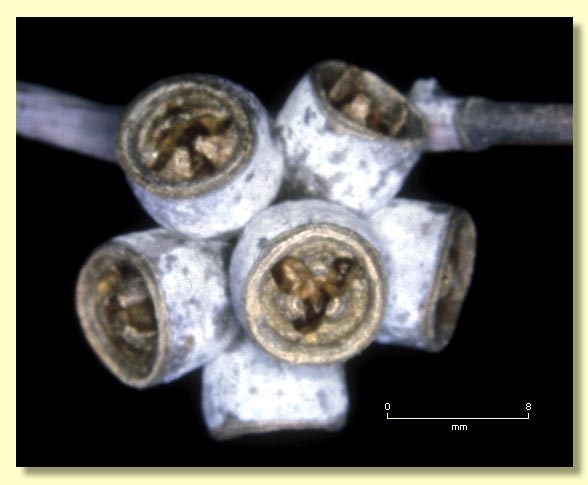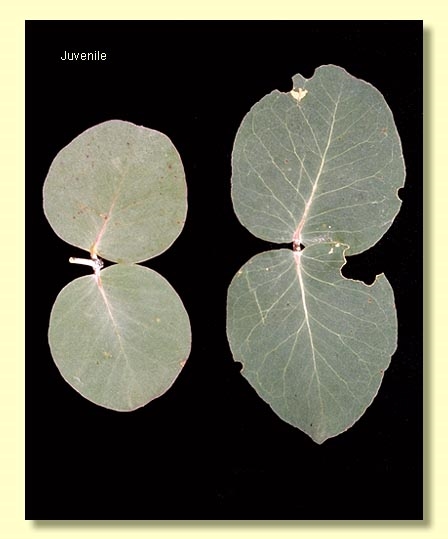Euclid - Online edition
Eucalyptus nortonii
Eucalyptus | Symphyomyrtus | Maidenaria | Euryotae | Globulares | Remanentes
Eucalyptus cordieri Trab. var. nortonii Blakely, Key Eucalypts 147 (1934). T: Woolomin, NSW, May 1927, E.A.Norton s.n.; lecto: NSW, fide L.A.S.Johnson, loc. cit.
Eucalyptus goniocalyx var. pallens Benth., Fl. Austral. 3: 230 (1867); E. cambagei var. pallens (Benth.) H.Deane & Maiden, Proc. Linn. Soc. New South Wales 25: 107 (1900). T: Snowy R., 10 Feb. 1854, F.Mueller s.n.; holo: K; iso: MEL.
[E. cordieri auct. non Trab.: W.F.Blakely, Key Eucalypts 147 (1934), fide L.A.S.Johnson, loc. cit.]
Bark rough to small branches, coarse and thick, fibrous or box-type, mottled grey and whitish or grey-brown; sometimes branches < 8 cm diameter smooth; branchlets glaucous.
Juvenile growth (coppice or field seedlings to 50 cm): stem rounded in cross-section, glaucous; juvenile leaves opposite and sessile for many nodes, orbicular to cordate, 2.5–9 cm long, 3–8 cm wide, conspicuously glaucous.
Adult leaves alternate, petiole 1.4–4 cm long; blade lanceolate to falcate, 8.5–30 cm long, 1.5–4 cm wide, base tapering to petiole, concolorous, dull, blue-green or grey-green to glaucous, rarely green, side-veins greater than 45° to midrib, densely reticulate, intramarginal vein parallel to and remote from margin, oil glands obscure.
Inflorescence axillary unbranched, peduncles 0.4–1.3 cm long, buds 7 per umbel, sessile or on pedicels to 0.2 cm long. Mature buds oblong to ovoid, 0.7–1.3 cm long, 0.3–0.6 cm wide, usually glaucous, longitudinally angled, scar present, operculum conical, stamens irregularly flexed, anthers cuboid or cuneate, versatile, dorsifixed, dehiscing by longitudinal slits (non-confluent), style long, stigma blunt, locules 3 or 4, the placentae each with 4 vertical ovule rows in each locule. Flowers white.
Fruit sessile or rarely with pedicels to 0.2 cm long, cup-shaped or cylindrical, 0.5–0.9(1.0) cm long, 0.5–0.7(1.0) cm wide, often slightly angled longitudinally, usually glaucous, disc level or descending, valves 3 or 4, near rim level or enclosed.
Seeds black, brown or grey, 1.5–2.5 mm long, ovoid or flattened-ovoid, often pointed at one end, lacunose, dorsal surface shallowly pitted, hilum ventral.
Cultivated seedlings (measured at ca node 10): cotyledons bilobed; stems rounded in cross-section, glaucous; leaves always sessile and opposite for many nodes, orbicular to cordate, 1.5–5 cm long, 0.5–6.5 cm wide, amplexicaul, margin entire or subcrenulate, apex rounded to emarginate, glaucous.
Flowering has been recorded in January, February, March, April, July and September.
A small, rarely medium-sized, tree of poor form occurring from the southern part of the Northern Tablelands of New South Wales through hilly country of the Southern Tablelands to eastern and central Victoria. Related to E. goniocalyx, it shares the coarse rough bark and sessile buds and fruit, but E. goniocalyx has green, glossy leaves and is never glaucous like E. nortonii, which has dull grey leaves and glaucous buds and fruit.
Eucalyptus nortonii belongs in Eucalyptus subgenus Symphyomyrtus section Maidenaria, a large group of species more or less restricted to south-eastern Australia, characterised by bilobed cotyledons, simple axillary inflorescences, buds with two opercula, stamens with versatile anthers and flattened seeds with a ventral hilum. Within this section, E. nortonii belongs in series Globulares subseries Remanentes, having sessile, juvenile leaves opposite for many pairs, small buds in clusters of seven and small fruit with a descending disc.














